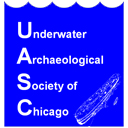 ***UASC January 2023 MEETING****
***UASC January 2023 MEETING****
Wednesday, January 25th @ 07:00 PM CST – Meeting of Underwater Archaeological Society of Chicago
Featured Presenter: Brian Abbott has over 20 years of underwater engineering inspections, hydrographic surveys and acoustic imaging experience.
Presenting: Acoustic Techniques and Technology for Surveying Shipwrecks
***THIS MONTH’S MEETING IS ZOOM ONLY***
On Zoom - Registration Link:
Pre-meeting Informal Social; 06:30 – 07:00
Business Meeting; 07:00 – 08:00
Featured Presentation: 08:00 – 09:00 (or later if necessary)
Acoustic Techniques and Technology for Surveying Shipwrecks
(Images are from Brian Abbott’s Facebook Page: )
With over 20 years of experience and access to some of the most advanced sonar equipment Brian Abbott does many acoustic images projects around the world including: ports, harbors, dams, bridges, tunnels, shipwrecks and many more objects. He has appeared on Televisions programs such as “Curse of Oak Island”, “Curse of Civil War Gold” and “Ancient Aliens”. He has published articles in professional and academic journals, including: “Journal of Ocean Technology” and “Bridge Design & Engineering”.
He will be speaking on the technology and techniques he uses to image underwater objects including shipwrecks. Techniques will include sector scan sonar, side scan sonar and multi-beam sonar. He will discuss some of his experiences he has had in doing this.
This promises to be a very interesting and educational presentation.
Biography:
Brian has over 20 years of project management, underwater engineering inspections, hydrographic surveys and acoustic imaging experience. He is the owner of Abbott Underwater Acoustics, L.L.C. He is an Engineer and HSE part 1 diver. He was also employed part time by Kongsberg-Mesotech as a special project person. This work includes but is not limited to training on Kongsberg-Mesotech equipment, testing of new prototype equipment and projects from homeland security, bridge inspections, ports and harbors inspections, Brian also does work in the archaeological filed and teaching courses on acoustic systems i.e. Scanning Sonar’s, Side scan sonar, Multibeam system, AUV Systems, Building 3D structures and cloud points underwater. He is also a Level III Nautical Archaeological Society (NAS) Instructor for sonars.
Brian Abbott refers to his infrastructure work as his “bread and butter,” yet he also does a lot of archeological work. In fact, Abbott just recently returned from Virginia where he was looking at shipwrecks from the Battle of Yorktown, the last battle of the American Revolution. Abbott surveys a lot of shipwrecks. He’s captured sonar images from Civil War battles, primarily ironclads, and searched the James River looking for forts or ships that may have been scuttled by the Confederacy during the war. Since 2014, he has also assisted in the search for World War II MIA (missing in action) servicemen throughout the Pacific. “The objective is to find a missing plane, tank, or landing craft underwater,” he says, “so I pack up the sonar gear, fly to an island battle site like Yap, Kwajalein, or Tarawa, where there alone we found twelve different tanks or landing craft underwater that could possibly hold the remains of Marines. It’s a very humbling experience to see these guys who disappeared in 1943 still there. In my world, they need to be brought home. It’s very emotional. There is some family member out there who wonders what happened to their uncle, brother, father, or grandfather, that they still care about. I was out there this year for three weeks looking for fighter planes and B24 bombers. We stop once we find the plane. If we find a component with a serial number on it, we determine who that plane belonged to and that person can be moved from MIA to KIA (killed in action). We don’t excavate remains. We just locate the target and turn it over to the authorities. They can sift through sand, clay and mud and still do genetic testing of one or numerous individuals.” There are still missing Gato class submarines (each with crews of over 60 crew members) as well as lost troop transport ships. In the 20th century alone, from World War I through Vietnam, there remain 80,000 American MIAs—58,000 of those from World War II.
His website is: .
